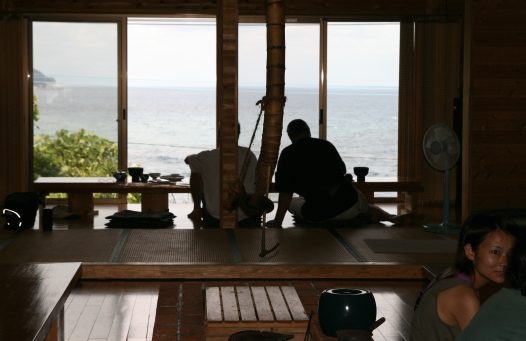|
Essays & Speeches
Haiku as Anti-Story
“The habit of story is of particular value to all of us. Story is the tool we use to take the disparate events of our lives and make coherence and perhaps even sense of them. . . . So far as I can discover, there has never been a journal about anti-story. In fact, only a single book has ever been published on the topic [and] haiku is nearly the only literary form that exploits it.” (August 2009)
So:Ba
Ba is the basis for much of what is done in haiku. “In fact, ba is the message of haiku. . . . a pointer to a kind of awareness that something of importance is happening in time and space . . .” (July 2008)
Skinning the Fish: Interpenetration in Haiku
“For many, perhaps most, practitioners of haiku, it's the process that matters, the growth of spirit and realization of our lives, moment by moment. But the actual products of this process, the haiku themselves, can help us gauge our progress, at least in literary terms. I offer this string of fish by way of illustration.” (Spring 2008)
Van Gogh’s Shoes: Thingness in Haiku
“How does haiku differ from other kinds of poetry? [Haiku] are not so much opposed to narrative as beyond it— [having] neither past nor future, and are not strictly narratable. As narrative fails, description takes over, bits and pieces obtrude. A description of bits and pieces is concerned with neither memory nor desire. It insists on the presence of that presented . . . ” (Spring 2008)
Soft Cheese
“World haiku is one of the success stories of contemporary literature. In a time when much of postmodern art consists of personal rants or the blanching of meaning from media, haiku simply and proudly rises above the chatter. Poets in over 50 countries and in more than 70 languages participate in an aesthetic wave emanating from the same source. . .” (September 2007)
Bridges
Which begins, “Haiku . . . is an island, and we its inhabitants. For a long time it seemed to be . . . a lonely speck of land.” From the viewpoint of literary culture at large, the concept of a ‘haiku hierarchy’ is developed, with presented examples, as a means for the teaching and evaluation of haiku. (August 2007)
|
|
State of the Art: Haiku in North America 2007
A speech given at The Second European Haiku Conference, Vadstena, Sweden. “It is reasonable to say that there is less assertion of individual qualities in American haiku today than there was twenty or thirty years ago... [and the] shift has been to publication on the internet. The most important consequence of this shift, I believe, has been the unification of language. . .” (June 2007)
Finding Its Direction
A retrospective of the best haiku published in the journal South by Southeast on the occasion of its 10th Anniversary (2003).
Around the World as Briefly as Possible
The convergence of theme and state of being between trips taken around the world and across the country is the topic of this speech, given at the Haiku Pacific Rim International Conference, Los Angeles. (November 2002)
Looking and Seeing: How Haiga Works
A penetrating discussion of haiga, including 30 illustrations of historical and contemporary works. (Setember 2002)
Beyond Kigo: Haiku in the Next Millennium
A discussion of season-words in modern haiku, from a global perspective. Acorn Journal of Contemporary Haiku, Supplement #1 (2000).
The World Haiku Conference, Tolmin
A talk on the possibilities of international haiku, and at the same time, personal involvement, at the inaugural World Haiku Association Conference in Tolmin, Slovenia. (October 2000)
Concerning Balkan Haiku
A speech presented at the Global Haiku Festival
Illinois, USA. (April 15, 2000)
Tapping the Common Well
From the Foreword to KNOTS: The Anthology of Southeastern European Haiku Poetry. (1999)
|
|

